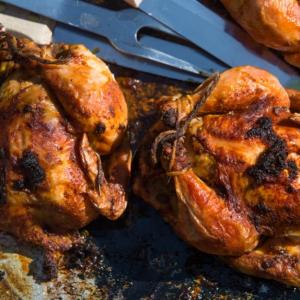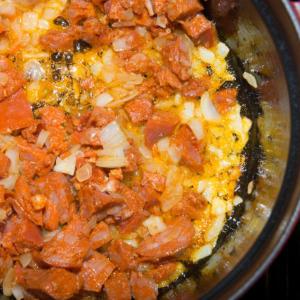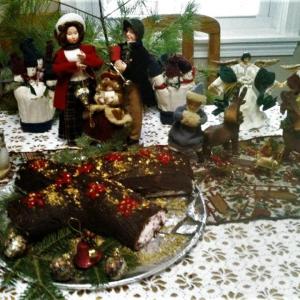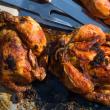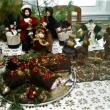Christmas around the world and at home
 Charpentier household’s Tió de Nadal makes an appearance at the Boothbay Register office. JOSEPH CHARPENTIER/Boothbay Register
Charpentier household’s Tió de Nadal makes an appearance at the Boothbay Register office. JOSEPH CHARPENTIER/Boothbay Register
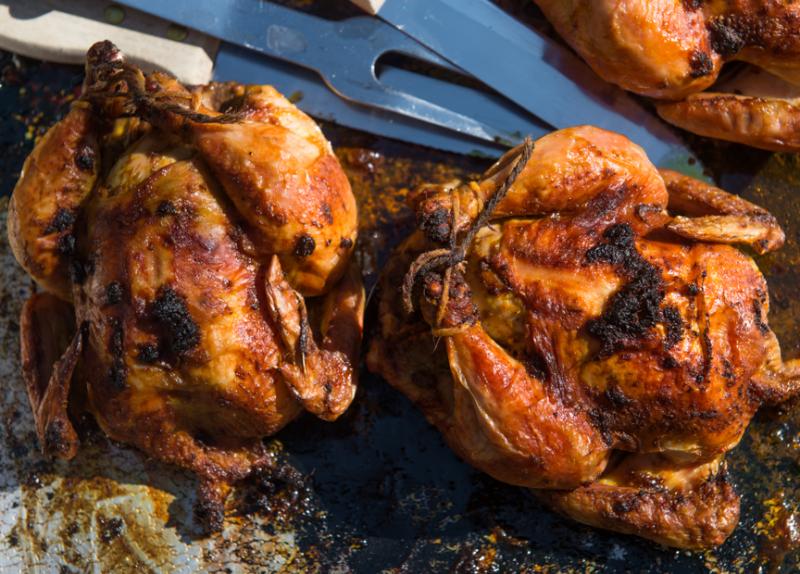 Two of Cherie Scott’s Garam Masala Cornish hens fresh out of the oven. Courtesy of Ted Axelrod Photography
Two of Cherie Scott’s Garam Masala Cornish hens fresh out of the oven. Courtesy of Ted Axelrod Photography
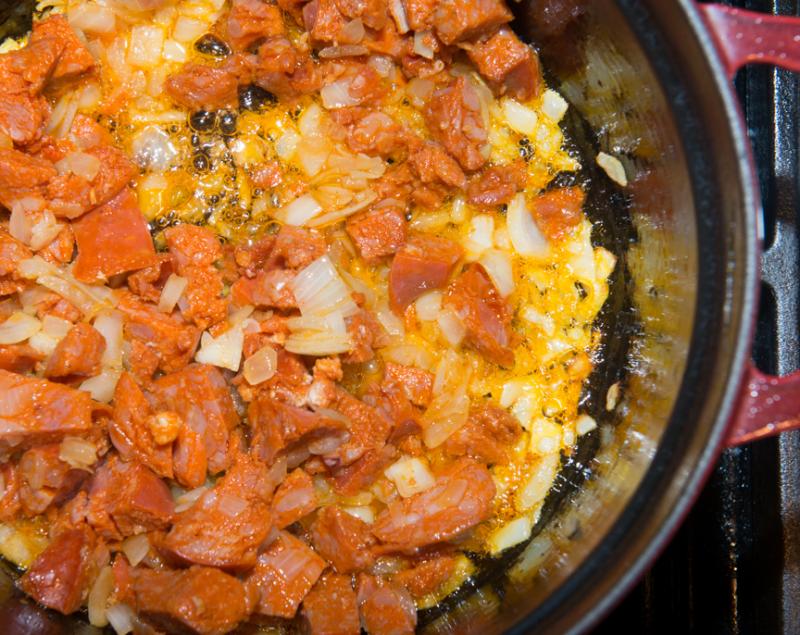 Cherie Scott’s chorizo Basmati rice stuffing is cooked before being stuffed into the Cornish hens. Coutesy of Ted Axelrod Photography
Cherie Scott’s chorizo Basmati rice stuffing is cooked before being stuffed into the Cornish hens. Coutesy of Ted Axelrod Photography
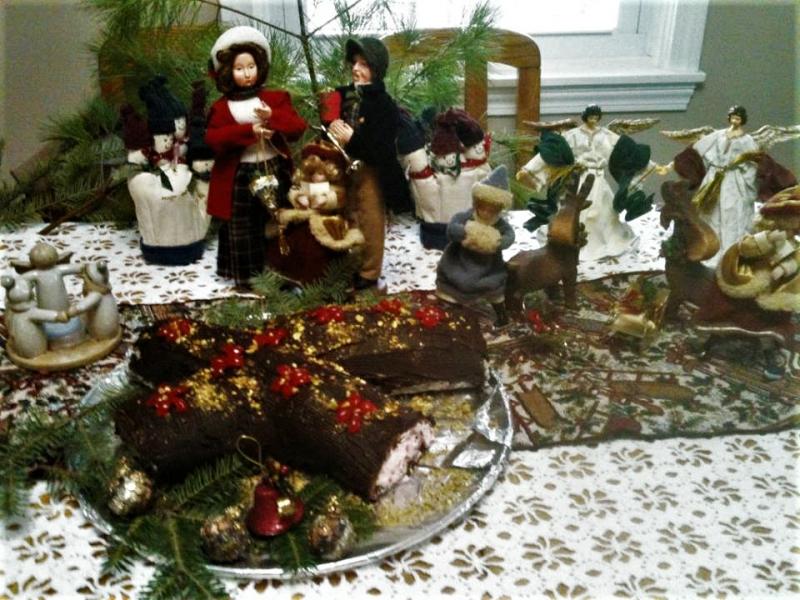 One of the many spins put on the classic French Christmas dessert, Bûche de Noël. Courtesy of Karen Charpentier
One of the many spins put on the classic French Christmas dessert, Bûche de Noël. Courtesy of Karen Charpentier
 Charpentier household’s Tió de Nadal makes an appearance at the Boothbay Register office. JOSEPH CHARPENTIER/Boothbay Register
Charpentier household’s Tió de Nadal makes an appearance at the Boothbay Register office. JOSEPH CHARPENTIER/Boothbay Register
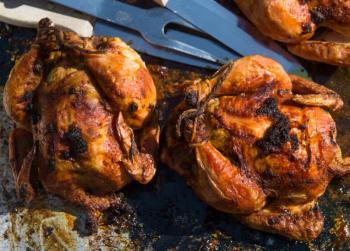 Two of Cherie Scott’s Garam Masala Cornish hens fresh out of the oven. Courtesy of Ted Axelrod Photography
Two of Cherie Scott’s Garam Masala Cornish hens fresh out of the oven. Courtesy of Ted Axelrod Photography
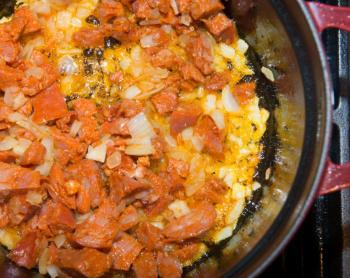 Cherie Scott’s chorizo Basmati rice stuffing is cooked before being stuffed into the Cornish hens. Coutesy of Ted Axelrod Photography
Cherie Scott’s chorizo Basmati rice stuffing is cooked before being stuffed into the Cornish hens. Coutesy of Ted Axelrod Photography
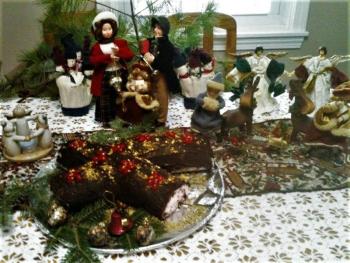 One of the many spins put on the classic French Christmas dessert, Bûche de Noël. Courtesy of Karen Charpentier
One of the many spins put on the classic French Christmas dessert, Bûche de Noël. Courtesy of Karen Charpentier
In the weeks leading to Christmas, a young Cherie Scott would steal one or two freshly made marzipan treats as her mother would turn her back to prepare more as a gift to friends and neighbors. Tasked with the deliveries around her building, Scott said it was always a short chore since there were barely any left when her mother was done preparing them.
Scott’s memory of holiday tradition in her home country of India is one of many that the Boothbay Register found reaching out to community members who once lived in different parts of the world.
Xavier Comas is from Catalonia, a region in northeast Spain along the Andorran and French borders. He is a retired economist living in Alna and, to his knowledge, is the only Catalan living in Maine. A Catalan Christmas is unique with details that can be found outside Catalonia only in some parts of Valencia, Andorra and southeast France.
“Everyone had the same tradition, essentially but now Christmas is celebrated in many different ways … and some traditions are stronger now than they used to be … The way we celebrate Christmas is similar, historically, to the way Italians and Hispanics celebrate Christmas,” Comas said.
One unique thing is Tió de Nadal (Christmas Log), a tradition likely thousands of years old, he said. A small, hollow log is usually propped up on two legs with a smiling face painted on the upward end. Beginning on the Feast of Immaculate Conception Dec. 8, the children are told to cover tió with a blanket to keep him warm. On Christmas Day, the children are asked to leave the room and pray that tió gives them good gifts – in the meantime, adults in the family stow small gifts under the blanket covering the log. When the children return to the room, they beat tió with sticks shouting at him caga tio! A child reaches under the blanket to pull out his or her gift, and then the children continue the beating.
Candy and pickles are among some of the small gifts bestowed on the children from the log, said Comas.
“I used to do it as a kid, but not everybody did it. Now, almost everybody does it … We do not have a tradition of present-giving on Christmas. Presents are given generally on Jan. 6, which is … the feast of the three kings and it is the commercial aspect of the holidays.”
Comas explained that the feast – Feast of the Epiphany – comes one day before schools go back into session, so it gave families the opportunity to give larger gifts, which the children would then be unable to occupy all of their time with since they go back to school the next day. He said that, now, Catalans celebrate on Christmas Day more often due to global commercialization and so children have time to enjoy their gifts.
Today, families will celebrate Christmas on Dec. 25 and 26 because people do not stay in the same area as they did generations before, Comas said. Both days are meant to spend time with both sides of the family.
Irene Marchenay teaches in Wiscasset, lives in Edgecomb and is from Paris, France where food and faith at Christmastime has become a cultural tradition.
“I think the big difference between the U.S. way and the French way is definitely the feast before Christmas,” said Marchenay.
The meal usually starts around 7 p.m. with the typical dishes of salmon and oysters. A large, chestnut-stuffed turkey often follows, but the main course, which Marchenay said is typical of all French dinners, is a white sausage usually cooked with apples and pears.
“That’s very much a staple for that evening. I still do it, but with chicken sausage. I just have to pretend.”
After around four hours of drinking champagne and eating, dessert is set on the table – Bûche de Noël. French for yule log, it is a rich and typically thin chocolate cake rolled into a log with a crème filling.
“The dessert is very traditional in France,” said Marchenay. “It is being replaced more and more by ice cream so dessert is a little lighter. After hours of eating heavy food, dessert is not a welcome sight … but it’s the one piece I miss tremendously.”
After the feast, families go to midnight Mass which lasts until the early hours of the morning. Upon returning home, families open gifts, but it’s more for the children than for the adults, Marchenay said. The next day, everybody stays home and relaxes while talking and playing with the children. Adults celebrate the season of giving during the New Year festivities and throughout January when they exchange money and good wishes for the year.
She noted other differences between a French Christmas and an American one. In France, children would wake to find their shoes filled with food, historically citrus fruit which could not be found in the markets. As exotic foods were being introduced into the markets, children would wake to find candy in their shoes. Now, most French children have stockings.
Said Marchenay, “One thing that I found extremely interesting is that Santa Claus comes through the chimney, but in France, he comes through the keyhole. He was not as jolly as he is here – he was a skinny guy and, in fact, at first he was dressed in green, not in red.”
Cherie Scott is from Mumbai, India. Her family is from the Goa province, a former Portuguese territory 350 miles south of Mumbai. Both her parents are from Portuguese and Indian descent and raised her and her sister as Catholics.
“In this small apartment building back in Mumbai, I had neighbors who were Hindus, Muslims, Parsis, Jains. We all celebrated one another’s special holidays and feasts. We did this year-round in perfect harmony and with no judgment. It was an enriching experience to share in these diverse cultural and rich culinary traditions and customs at a young age. Of course the best part for me was when it was our turn to share the Christmas spirit and drop off my mother’s delectable handmade Portuguese-infused treats with my delighted neighbors.
“My mother took no shortcuts – she had no food processors. She would stand in her kitchen for hours grating and processing all of the coconut by hand so she could make fresh coconut milk for a coconut dessert.”
Additionally, she would toast and then grind Indian spices like turmeric, cinnamon, cardamom, cloves, black pepper, ginger and garlic to marinate her famous chorizo and basmati-stuffed Cornish hens. Being that Christmas was so “food-centric” as Scott put it, there was never any gift-giving, but as Catholics, Mass was still a big deal especially for Scott and her sister who sang in the choirs, performed in the nativity and in skits, and helped with bake sales.
“My mother’s long hours weeks before and during the holidays in the kitchen paid off every Christmas as she put so much passion into every aspect of making our holiday memorable and festive.”
Event Date
Address
United States


